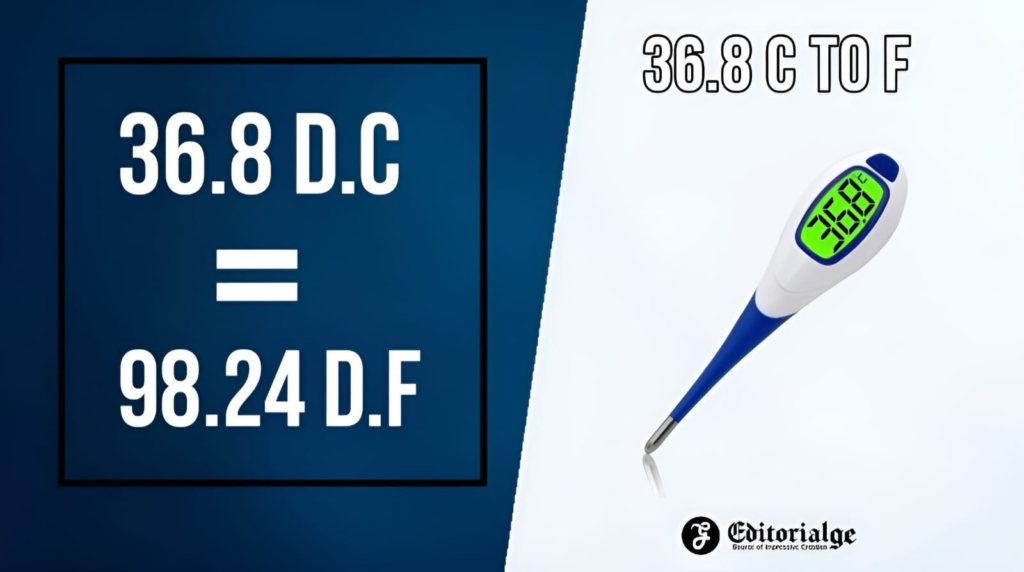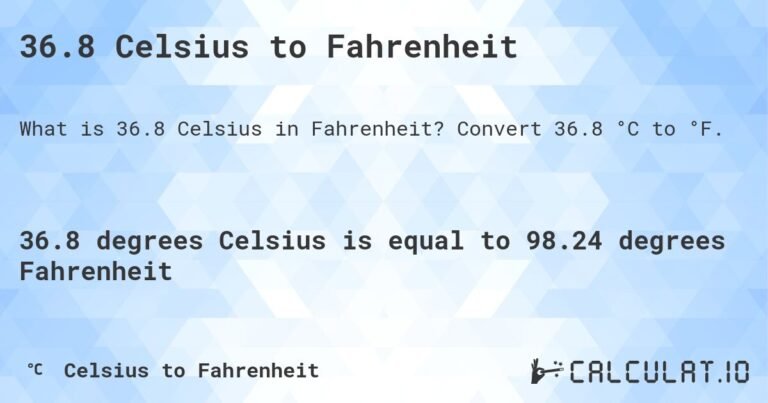Temperature can sometimes be confusing, especially when you have to convert it between two scales. For example, 36.8°C may seem like a mystery to some, but don’t worry! This guide will explain everything in a simple way that even a 10-year-old can understand.
What Does 36.8°C Mean in Fahrenheit?
When you see 36.8°C, it’s in the Celsius scale, which is used in most countries around the world. To find its equivalent in Fahrenheit, we use a simple formula. Using this formula, 36.8°C equals 98.24°F. That’s just a little below the normal human body temperature, which is about 98.6°F.
Celsius is great for measuring things scientifically, while Fahrenheit is commonly used in the United States for weather and body temperature. Knowing how to convert between the two is helpful in many situations!
Why Do We Convert Celsius to Fahrenheit?
People convert Celsius to Fahrenheit for several reasons. One of the most common reasons is to understand temperatures in a different region. For example, if you live in the United States, you’ll likely see weather forecasts in Fahrenheit, but if you’re visiting Europe, temperatures are displayed in Celsius.
Converting also helps when discussing temperature with friends or reading instructions that use a different scale. Whether it’s for cooking, studying science, or traveling, being familiar with both Celsius and Fahrenheit is super useful!
Quick Reference: Common Temperature Conversions
Some temperatures are so commonly used that it’s helpful to know their values on both scales. Here’s a simple explanation:

Freezing Point of Water
Water freezes at 0°C, which equals 32°F. This is the temperature where water turns into ice. Easy to remember, right?
Room Temperature
Room temperature is around 20°C to 22°C, which is approximately 68°F to 72°F. This is the temperature where most people feel comfortable indoors.
Body Temperature
Normal human body temperature is about 37°C, which equals 98.6°F. This is close to 36.8°C, so if someone measures this, it’s considered healthy.
Boiling Point of Water
The boiling point of water is 100°C, which equals 212°F. At this temperature, water turns into steam. It’s a common reference point used in science and cooking.
Imagine you’re boiling water for tea. If you’re in a lab using Celsius, the water boils at 100°C, but your kitchen thermometer in the United States would show 212°F.
How to Convert Other Celsius Temperatures to Fahrenheit
Converting Celsius to Fahrenheit isn’t difficult once you know the formula:
F=(C×9/5)+32F = (C \times 9/5) + 32F=(C×9/5)+32
Let’s break this down step by step:
- Multiply the Celsius temperature by 9/5.
- Add 32 to the result.
For example:
- To convert 25°C to Fahrenheit:
- 25×9/5=4525 \times 9/5 = 4525×9/5=45
- 45+32=77°F45 + 32 = 77°F45+32=77°F
Try it yourself! Practice makes perfect.
Multiply
Multiplication is a big part of the conversion process. When converting Celsius to Fahrenheit, always start by multiplying the Celsius temperature by 9/5. This step ensures that the scale difference between Celsius and Fahrenheit is accounted for.

Why Knowing Both Scales Is Useful
Understanding both Celsius and Fahrenheit helps in everyday life. For example, when you’re baking cookies with a recipe from Europe, you’ll need to convert Celsius to Fahrenheit for your oven. Similarly, if you’re checking the weather in a different country, knowing how to convert will make things much clearer.
The History of Temperature Scales
Temperature scales have fascinating origins. Let’s take a look at the Celsius and Fahrenheit scales:
Celsius Scale
The Celsius scale was created by Anders Celsius, a Swedish scientist, in the 1700s. It’s based on the freezing point (0°C) and boiling point (100°C) of water. This scale is widely used for scientific purposes because it’s simple and logical.
Fahrenheit Scale
The Fahrenheit scale, on the other hand, was developed by Daniel Gabriel Fahrenheit. It’s based on a different system where water freezes at 32°F and boils at 212°F. This scale is most commonly used in the United States and some Caribbean countries.
While it might seem more complicated, it’s familiar to anyone living in the U.S. Knowing how to navigate between Celsius and Fahrenheit makes life easier.
The Bottom Line
Understanding temperature conversion doesn’t have to be tricky. Whether it’s 36.8°C or any other value, the process becomes simple with practice and a basic understanding of the formula.
Next time you hear a temperature in Celsius or Fahrenheit, you’ll be able to figure it out easily. Now go ahead and impress your friends with your newfound knowledge of 36.8°C to Fahrenheit!


